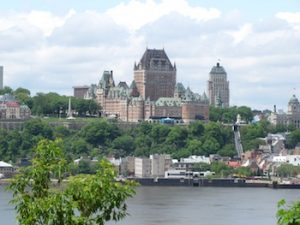
Quebec is one of the safest cities on the world, especially for women, my new friend tells me.
That’s lucky, I think, because I’ve just jumped into his car and we’re driving up into deserted forests. If I disappear, nobody will ever know why.
All such thoughts vanish as my impromptu tour guide Philippe Guerriere starts telling me about the battles that raged in Quebec between French and English soldiers, leaving a stunning legacy of fortresses and ramparts.
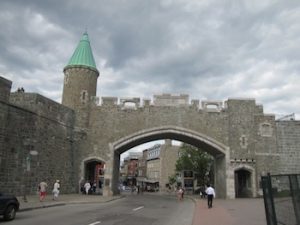
This gorgeous Canadian city is surrounded by walls built between 1608 and 1871 as the opposing armies fought, lost and fought back again.
Inside the walls little has changed for centuries. The entire old town is deservedly a UNESCO World Heritage Site, rich with twisting cobbled streets and impressive historic monuments. Topping it all is the eye-popping Chateau Frontenac, the most photographed hotel in the world. It’s an incredible sight of rambling turrets and towers, conical roofs and pointy spires, built in 1893 by the Canadian Pacific Railway Company to rest its well-heeled travellers.
The hotel is even more picturesque because of its setting, perched on a sheer cliff that rises up from the lower town full of narrow alleys that now house boutiques and art galleries.
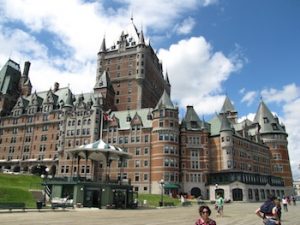
Along the cliff top in front of Chateau Frontenac is the elegant Dufferin Terrace, a wide promenade offering brilliant views of the city and the St Lawrence River far below.
The summer fun sees buskers and acrobats performing here, but in the long, harsh winters the main spectacle comes at the far end of the terrace where a man-made slope freezes into a breakneck toboggan run.
Quebec is built in three parts: the old fortified town on Cap Diamante cliff; the lower town, starting at the base of the cliff and swinging around a headland before opening up to form the suburbs; and the upper town, outside the fortress walls but higher that the lower town. This historic upper area is great for lovely bars and restaurants. And don’t worry about the calories – Quebec will make you fit as you climb up and down between the different sections and walk far further than intended because you can’t help exploring just one more intriguing street or turning one more corner.
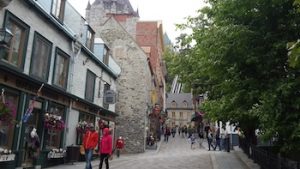
The tourist office in the old city is a great place to start, with helpful staff and a very welcome coffee machine. I spent a couple of hours in jail too. Oh, let me rephrase that – I spent a couple of hours touring a former jail, the first prison in the city.
Guides at the Morrin Centre wear costumes dating back to 1808 and show you the stark, solid prison cells. Some of the detained scallywags had done nothing more than steal some bread. Tougher criminals often ended their days in a public hanging from a balcony over the front door. Today the Morrin Centre is a lovely library with some books surviving from the 16th century.
Now I’m miles away from the city as Philippe drives me to Wendake, a reservation where the native Huron-Wendats tribe lives. I’d pictured weather-beaten chiefs in feather headdresses living in teepees, but modern First Nation life is nothing like that. The tribe now runs the Wendake Hotel which features a museum and a long house, a traditional wooden home big enough for an extended family. I explore it with delight, climbing up to a second level of living space spread with furs behind walls made of branches tightly lashed together.
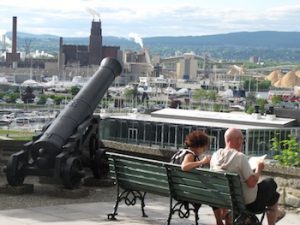
Next we drive through sweeping forest scenery to a sugar shack, where maple syrup is harvested in the foothills of the mountains. Maple trees produce a sweet sap every spring, which the First Nation people discovered when their arrows pierced the bark and came out dripping. Now it’s a full-on industry, and this shack, the Erabliere Du Lac-Beauport, taps 8,000 trees. Director Lorraine Todd explains the production process, before I leave sucking maple syrup sweets.
The shack has a taxidermy collection too, displaying massive wolves, moose and brown bears. In the long Canadian winters this whole area is drowned in deep, unrelenting snow, and I can almost hear the wolves howling and the bears a’grunting. I’m really glad I chose to travel in spring.
I’d met Philippe when we sat next to each other at a show by the Ecole de Cirque de Quebec, the local circus school. The city is the home of Cirque du Soleil, and every youngster yearns to be a clown, an acrobat or a trapeze artist. The school is based in a defunct church and when the free afternoon performance was rained off, one of the tutors, Gaetan Verret, showed me around instead. Soon he had me bouncing around to test the specially sprung floor while he clowned about walking on his hands to prove he’s still got it at the age of 60.
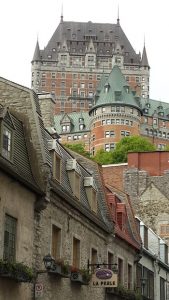
It was such fun that I bought a ticket to the show that evening, thrilled to catch the students just before they join professional.
The friendly nature of the locals extends to Sam Dubois too, a guide who offers tips-only walking tours. (www.afreetourofquebec.com). He amused his group with lovely stories about the city, pointed out where classic movies were filmed, and told us that the medieval looking gates in the city walls aren’t as old as they appear. The original gates were so narrow that over the years they’ve been replaced by wider, more practical but still ancient-looking versions.
Sam points out his favorite bar, the city’s poshest restaurant and recommends some excellent museums. I’ve only come for four days, and I wish I’d stayed a week.

